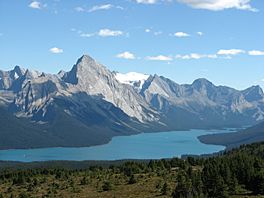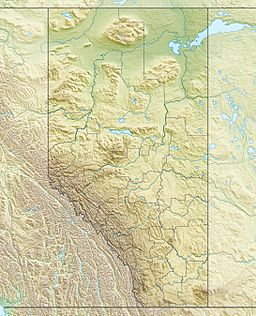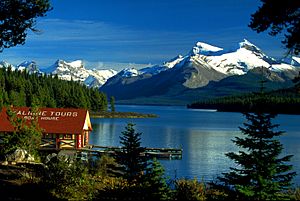Maligne Lake facts for kids
Quick facts for kids Maligne Lake |
|
|---|---|

Maligne Lake and Samson Peak
|
|
| Location | Jasper National Park, Alberta |
| Coordinates | 52°39′52″N 117°32′01″W / 52.66444°N 117.53361°W |
| Lake type | oligotrophic |
| Basin countries | Canada |
| Max. length | 22.5 km (14.0 mi) |
| Max. width | 1.5 km (0.93 mi) |
| Surface area | 19.71 km2 (7.61 sq mi) |
| Average depth | 35 m (115 ft) |
| Max. depth | 97 m (318 ft) |
| Shore length1 | 45 km (28 mi) |
| Surface elevation | 1,670 m (5,480 ft) |
| Settlements | Jasper |
| 1 Shore length is not a well-defined measure. | |
Maligne Lake (mə-LEEN) is a beautiful lake in Jasper National Park, Alberta, Canada. It's famous for its amazing blue water, the tall mountains around it, and Spirit Island. Spirit Island is a small island that is photographed a lot!
The lake is about 44 km (27 mi) south of Jasper town. You can get there by car or shuttle bus. Boat tours take visitors to Spirit Island from spring to autumn. If you love hiking, the 44 km (27 mi) Skyline Trail starts here. It's Jasper's most popular long hike. Other fun day hikes include the Opal Hills and Bald Hills trails. In winter, people enjoy cross-country skiing and snowboarding.
Maligne Lake is about 22.5 km (14.0 mi) long. Its deepest spot is 97 m (318 ft), at the south end. On average, it's about 35 m (115 ft) deep. The lake sits high up, at about 1,670 m (5,480 ft) above sea level. From the Maligne Lake Day Lodge, you can easily see Leah and Samson Peaks. You can also spot Mount Paul to the east.
Three glaciers are visible from the lake: Charlton-Unwin, Maligne, and Coronet. The lake has a healthy population of rainbow trout and brook trout. It's a great place for fishing, kayaking, and canoeing. Parks Canada has three campsites that you can only reach by canoe. These are at Hidden Cove, Fisherman's Bay, and Coronet Creek.
The Maligne River feeds Maligne Lake from the south. It also drains the lake to the north. The name "Maligne" comes from a French word meaning "wicked" or "turbulent." Father Pierre-Jean De Smet used this word to describe the fast-flowing river. The name soon spread to the lake, canyon, and mountains.
Contents
History of Maligne Lake
Local First Nations people knew Maligne Lake well. They called it Chaba Imne, which means Beaver Lake. A First Nations man named Samson Beaver drew the first map of the lake in 1907. He showed it to Mary Schäffer. Schäffer was an explorer and artist. She was the first non-native person to visit the lake. Because of this, she was given credit for "discovering" it. She then named it Maligne Lake.
The first European to see the lake was Henry McLeod in 1875. He saw it from high in the mountains while scouting for the Canadian Pacific Railway. But he didn't go down to the lake itself.
On June 8, 1908, Mary Schäffer and her friend Mary (Mollie) Adams set out. With Samson Beaver's map and guides Billy Warren and Sid Unwin, they reached the lake. They explored it using a raft they called HMS Chaba. The Canadian government asked Schäffer to return in 1911 to map the lake in more detail. She also named several mountains and peaks. Her books about the area brought many tourists to the region.
Maligne Lake has two historic buildings. The Maligne Lake Chalet was built in 1927 by Colonel Fred Brewster. It was part of his "Rocky Mountain Camps." For a while, it was the biggest and fanciest place to stay in Jasper National Park.
The other historic building is the boathouse. Donald "Curly" Phillips built it in 1928. He used it for his guiding and fishing business. That same year, he built the first tour boat for Maligne Lake. He named it Leah after Samson Beaver's wife, Leah Samson. Curly Phillips lived in his boathouse until he died in an avalanche in 1936. These historic buildings are now cared for by Maligne Lake Tours.
Fish in Maligne Lake
Curly Phillips is known for bringing brook trout to Maligne Lake. He carried them over land in barrels! Later, in the 1970s, Parks Canada introduced rainbow trout. This was done to make sport fishing more challenging. The biggest rainbow trout ever caught in Alberta was caught here. It weighed 20 pounds 4 ounces or 9.2 kilograms! This record fish is now owned by Currie's Guiding and Tackle in Jasper. The third largest brook trout in the world was also caught here. It belongs to David Robson of Hinton, Alberta.
Wildlife Around Maligne Lake
Even though this is a high-altitude lake, lots of animals live here. You might see grizzly bears and black bears. Other large animals include mule deer, caribou, wolves, and moose. Bald eagles, golden eagles, and osprey also live here. They hunt the fish in the lake.
How Maligne Lake Was Formed
Maligne Lake is the biggest lake in Jasper National Park. The valley where the lake sits was carved out by huge glaciers. The lake was formed when the last glacier left a pile of rock and dirt. This pile, called an end moraine, acted like a dam at the north end of the lake.
The tallest mountain nearby is Mount Brazeau (11,386 ft or 3,470 m). It's southeast of Maligne Lake. The highest mountains are at the south end of the lake. They are made of rock layers that are about 4,000 to 5,000 years old.
The sides of the valley look different as you go north. The east side has steep limestone cliffs. These form the jagged Colin Range. On the west side, you'll see the Maligne Range. These mountains are made of different types of rock. They look smoother because glaciers moved over them and rounded their shapes.
The Maligne River flows into the north part of Maligne Lake. At the very north end of the lake, the river flows out into a narrow channel. It then goes to Medicine Lake. What's cool is that you can't see the river flowing out of Medicine Lake! That's because the Maligne River flows underground for about 9 miles (14 km). It then reappears in a deep canyon, about 180 feet (55 m) deep.
The Maligne Valley is shaped like a "U." This means it was carved by glaciers. It's also a "hanging valley." This happens when a main valley (like the Athabasca Valley) is carved deeper by glaciers than a side valley (like Maligne Valley). This leaves the side valley "hanging" above the main one.
See also
 In Spanish: Lago Maligne para niños
In Spanish: Lago Maligne para niños






